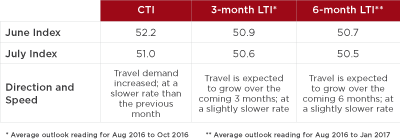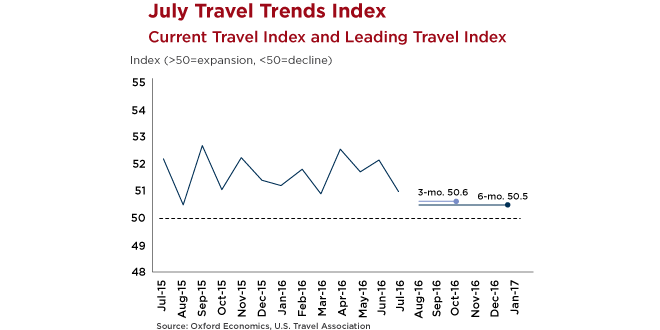WASHINGTON (September 6, 2016)—Domestic leisure travel—which has been powering overall travel growth on its own amid persistent softness in the business and international markets—has begun to show signs of its own slowdown, according to the U.S. Travel Association's latest Travel Trends Index (TTI).
In July, domestic leisure travel grew at its slowest rate since December 2012. Though the domestic sector will continue to grow through the rest of 2016, it will do so at a much more anemic pace, as consumer confidence boosted by lower fuel prices begins to wane.
Domestic business travel, which registered in positive territory for the second month in a row, will decline again as 2016 comes to a close, according to the TTI's Leading Travel Index (LTI).
While travel grew overall in July 2016, international inbound travel slowed again after an initial uptick in June—a bump that U.S. Travel economists believe reflected some rebound from June 2015's significant drop in international visits more than the start of a new, robust growth trend. A variety of factors, including the continued effects of Britain's decision to leave the European Union and the continued strength of the dollar, weighed on international inbound travel growth in July. The LTI projects that these variables will most likely drag international inbound growth to a standstill by the end of this year.
Despite the storm clouds, the travel industry at large remains in expansion mode, as the CTI has registered above the 50 mark for 79 straight months. The July Current Travel Index (CTI) registered at 51.0 in July—still on the positive side, although below the 6-month moving average of 51.7 (numbers above 50 indicate growth, and scores below 50 show contraction).
In the full TTI report, the 3- and 6-month LTI readings of 50.6 and 50.5, respectively, indicate that U.S. travel overall is expected to grow at a rate of around 1.1 percent through January 2017.
"What we're seeing here is a reversal from the post-recession economic expansion, when international inbound travel ignited the recovery," said U.S. Travel Association Senior Vice President for Research David Huether.
"International inbound travel's return to sluggish growth patterns in July was to be expected, given the dollar's continued dominance and Europe's Brexit hangover. Even as it weakens slightly, domestic leisure travel will continue as the main source of strength for the travel industry."
The TTI consists of the Current Travel Index (CTI), which measures the number of person-trips involving hotel stays and/or flights each month, and the Leading Travel Index (LTI), which measures the likely average pace and direction of business and leisure travel, both domestic and international inbound. It assigns a numeric score to every travel segment it examines—domestic and international, leisure and business—in current, 3-month and 6-month predictive indicators. As with many indices similarly measuring industry performance, a score above 50 indicates growth, and a score below 50 indicates contraction.
The U.S. Travel Association developed the TTI in partnership with Oxford Economics, and draws from multiple data sources to develop these monthly readings. In order to compile both the CTI and LTI readings, the organization's research team utilizes multiple unique non-personally identifiable data sets, including:
- Advance search and bookings data from ADARA and nSight;
- Passenger enplanement data from Airlines for America (A4A);
- Airline bookings data from the Airlines Reporting Corporation (ARC); and
- Hotel room demand data from STR.
Learn more about the Travel Trends Index.
Click here to read the full report.



